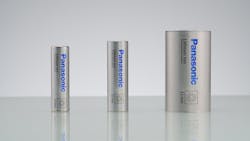Panasonic’s EV Batteries to Integrate Sila Silicon Anodes
This article is part of the TechXchange: EV Battery Management.
Driven by the push of regulators, the pressing need for environmental sustainability, and an electrification wave capturing all segments of the consumer car market, Panasonic Energy and battery materials company Sila signed a commerical agreement for Sila's nano-composite silicon anode known as Titan Silicon. The resulting battery, from Panasonic, is expected to enable automakers to increase EV performance, improve vehicle range, and reduce charge times.
Sila's Titan Silicon is a graphite anode replacement said to deliver a 20% increase in EV range, with a development path to double those gains. The company's nano-composite silicon also shrinks battery charging time, with the aim to drive charge times down to only 10 minutes.
Sila’s anode materials, produced in the company’s plant in Moses Lake, Wash., will be optimized for Panasonic’s next-generation lithium-ion batteries. According to Panasonic Energy, in theory, silicon has 10X the capacity of graphite that’s typically used in today's battery anodes.
The Drive Toward 1000-Wh/L Density
To meet the rapidly growing demand for EVs, Panasonic Energy plans to increase global production capacity of automotive batteries to 200 GWh by FY2030/2031. The company has also promised to deliver increased volumetric energy density to 1000 Wh/L in the same timeframe. By partnering with Sila to optimize the performance gains already achieved with Titan Silicon, Panasonic Energy expects to take a big step toward achieving its goal of 1000 Wh/L.
“By integrating Sila's groundbreaking battery material with our advanced cell manufacturing capabilities, we believe that we can address concerns such as range anxiety and charging time and contribute to accelerating the adoption of EVs,” said Shoichiro Watanabe, Executive Vice President of Panasonic Energy.
“This partnership represents a significant milestone for Sila, our customers, and the industry at large, and will be key to accelerating consumer EV adoption,” said Gene Berdichevsky, Co-founder and CEO of Sila.
Sila was the first to bring next-generation anode materials to market with the launch of Titan Silicon in 2021. In 2022, the company was the first next-gen battery materials company to sign a supply agreement with a global auto manufacturer, Mercedes Benz. The company said its materials will support EVs, starting with the Mercedes-Benz G-Class series scheduled to debut in 2025.
Sila aims to produce enough material to power one million EVs in the next five years. Mercedes-Benz initially invested in Sila back in 2019, seeking advanced battery material for its future EV lineup.
Reduced Swelling Thanks to Nano-Composite Materials
Range is a key differentiator for EVs, and a critical performance metric. Titan Silicon’s 20% higher energy density—for example, taking a car from 335 miles to over 400 miles range—enables batteries to either be the same size with more energy, or smaller with the same energy. Importantly, according to Sila, this increase in energy density comes without compromising cycle life or cell safety, and it works in any form factor.
Sila also said that the U.S.-manufactured Titan Silicon generates substantially less CO2 per kWh than graphite during production, reducing an EV's environmental impact and enabling automakers to meet requirements for Inflation Reduction Act tax credits.
Graphite has been the anode material of lithium-ion batteries practically since they were invented. There are two major types: natural graphite, which is mined and then purified; and synthetic graphite, which is a byproduct of crude oil refining.
While silicon promises much higher energy density and faster charging cells due to the different way that it stores lithium ions, the major issue with silicon anodes has been swelling. When a pure silicon anode is charged, it expands by 300%, and then contracts by that same amount during discharge (graphite only expands and contracts by 7%). This swelling results in severe anode and electrolyte degradation, and as a result, batteries with pure silicon anodes haven’t been stable enough for commercial application.
Nano-composite silicon (NCS) materials may be the answer. NCSs are made of small pieces of high-capacity silicon in a porous framework. Empty spaces enable the silicon particles to expand and contract as the battery is charged and discharged. NCS pairs the higher energy density of silicon with the safety and stability required for use in EVs.
According to Sila, Titan Silicon delivers a 20% boost in energy density, which is delivered while maintaining swelling at the same level as graphite-based pouch cells. Titan Silicon is also said to be 5X lighter than graphite at the material level, bringing about 15% lighter cells. This results in either better vehicle handling or, if smaller batteries are required for smaller battery designs, making room for additional storage, cabin space, or new vehicle features. The company claims to have achieved these results without sacrificing cycle life or safety.
Panasonic Energy plans to increase battery energy density by 25% by 2031. It will replace a larger proportion of graphite in the anode with silicon to help it achieve this goal and further enhance EV performance.
Panasonic supplies batteries to Tesla at its Nevada plant in the U.S. Construction is underway for another plant in Kansas.
Read more articles in the TechXchange: EV Battery Management.

